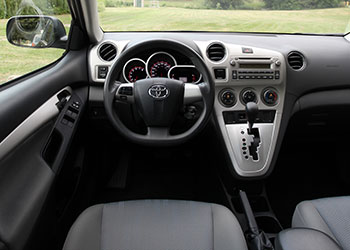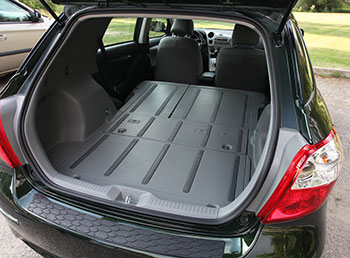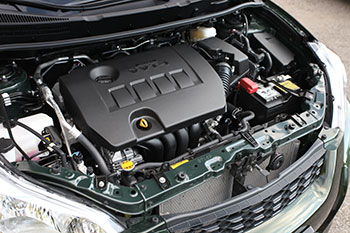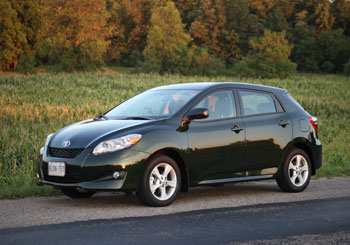Toyota Matrix 2009-2014: pros and cons, common problems
By Vlad Samarin. Updated: November 17, 2022
The Toyota Matrix is the most practical small wagon. Sharing its platform with the Corolla, the Matrix offers 49.4 cubic feet of flat cargo space covered with durable plastic.
It's also one of the few small cars suitable for tall drivers, as it offers plenty of headroom.The upright driving position makes the entry and exit easy and provides excellent front visibility. The Toyota Matrix with a 1.8L engine is good on gas. What are the pros and cons? and the common problems?
Pros:
- It's a practical reliable car that is not only good on gas (with 1.8L engine), but offers flat cargo space comparable to that of some SUVs.
- The 1.8L engine can last long with good care and even if the engine or transmission will need to be replaced at higher mileage, used units are reasonably priced.
- Upright driving position, good front visibility, plenty of headroom.
- Not very expensive to buy, cheap to maintain, easy to work on.
- Interior materials could be better, seats stain easily.
- Like any tall car, the Matrix is sensitive to strong side winds.
- Thick rear pillars create blind spots in the back.
- Seats are not the most comfortable.
A failed rear oxygen sensor (Bank1 Sensor2) could cause the code P0138. Replacing the rear O2 sensor will cost $290-$380. It's a fairly simple repair.
A failed ignition coil can cause the engine to misfire and codes P0301-P0304. The part is not very expensive and is easy to replace. It's a good idea to replace all the spark plugs if they are old together with the ignition coil.
Water pump failures are not uncommon. The cost to replace it varies from $380 to $540; it's not a very difficult job. Symptoms of a bad water pump include pinkish fluid leak on the passenger side of the engine compartment. Sometimes a bad water pump will produce a grinding or screeching noise when failing. When replacing a water pump, it's a good idea to change the drive belt as well. Watch these videos about water pump replacement.
Rear brakes can wear prematurely if not serviced regularly; to prevent brake calipers from seizing up, brakes must be serviced at least once a year.
Struts and wheel bearings can fail at higher mileage. Replacing one wheel bearing costs from $260 to $370. The cost to replace both front struts is around $580-$840.
Advertisement
The service bulletin T-SB-0087-09 for the 2009 Corolla / Matrix describes a brief knocking/rattling noise from the 2ZR engine when started cold. According to the bulletin, it's caused by a faulty camshaft timing gear assembly (VVT gear). The VVT gear must be replaced to correct the problem. The repair costs from $380 to $590. There are a few videos on Youtube showing the repair.
A faulty starter motor can cause the vehicle not to start; it would only produce a single click. In cases like this, the battery must be tested first. Corroded battery terminals can also cause this problem. Replacing a starter motor will cost from $250 to $520; it's also a fairly simple job.
A failing alternator can cause the battery to be low on charge and the battery warning light to come on while driving. Replacing an alternator will cost 0.7-1.0 hours of labor plus the part.
2.4L engine: Toyota issued Warranty Enhancement Program ZE7 to address excessive oil consumption in the 2AZ engine. Check with a Toyota dealer if your vehicle is eligible. This forum has some information. There have also been numerous complaints about stripped threads in the cylinder block for the head bolts in the 2AZ 2.4L engine. The repair is expensive; watch this video. From the information we have, both of these problems were reported in the 2009 model year of this generation, that in our view should be avoided. Check for recalls at the NHTSA website.
Engines: The base engine is a 132-hp 1.8L DOHC 2ZR-FE (same as in the Corolla). It's a durable engine that can last long with good care. Watch this video about the Toyota Corolla with over 500,000 miles; it has the same engine.
An optional 158-hp 2.4L 4-cylinder 2AZ-FE engine was available in S, XRS and XR (Canada) trims. There were some complaints about oil consumption and stripped threads in the cylinder block in the 2009 model year. The 1.8L engine is a more reliable choice in our view, although it needs to be maintained well to last.
Timing belt or chain? Both, the 2ZR-FE and 2AZ-FE use a maintenance-free timing chain; there is no timing belt. The timing chain only needs to be replaced if it's stretched.
Fuel economy The EPA rates the 2009-2013 1.8L Matrix with a manual transmission at 26 mpg (9.0 L/100 km) city and 32 mpg highway (7.4 L/100 km). The 1.8L Matrix auto gets 25 mpg city, 31 mpg highway. This means that on a long trip, you can travel in the 1.8L Matrix with an automatic transmission for up to 396 miles (697 km) on one tank of gas. The 2009-2013 Matrix with a 2.4L engine auto is rated at 21/29 mpg.
Handling and ride: The Matrix handles well, with responsive steering and a good road feel. The ride is comfortable, but you will hear some engine noise on acceleration, as well as some road noise. The 1.8L engine is peppy for daily driving, but feels a bit underpowered when fully loaded.
Lineup: In the U.S., the 2009 Matrix came in Base, S and XRS trim levels, although for 2012, only the base L and sporty S models were available. In Canada, the lineup consisted of the Base, XR, XRS and AWD models. 2013 was the last model year available in the U.S. In Canada, the Matrix was discontinued after 2014.
Mechanical: Transmission choices include a five-speed manual or four- or five-speed automatic. All-wheel drive is only available with a 2.4L engine and an automatic transmission. Antilock brakes are standard. Vehicle Stability Control and Traction Control were optional in earlier models; standard from 2010 in the U.S. and from 2011 in Canada.
Overall: The Matrix is a practical fuel efficient low-maintenance wagon. With the addition of a roof rack and some special gear, the Matrix can transport two kayaks or a canoe. The 1.8L engine is a better choice, as it's good on gas and can last long with good maintenance. The 2009 Matrix with the 2.4L engine should be avoided.
Similar cars: Pontiac Vibe is the mechanical twin of the Matrix, but it was discontinued after 2010. The Honda Fit is smaller and has a firmer ride, but is otherwise practical and reliable too. The Toyota Corolla is pretty much the same car. The Mazda 3 is also reliable; it offers sportier handling and a more upscale interior, but the interior space is tight. The Honda Civic is more sporty and more fuel efficient on the highway, but seats are low to the floor, making entry and exit more difficult. The Nissan Versa and Sentra are less reliable. Dodge Caliber is larger but also less reliable. Read also: What mileage is OK for a used car?
Similar cars:
Honda Civic 2006-2011
Mazda 3 2010-2013
Toyota Matrix 2003-2008
Dodge Dart 2013-2016
Toyota Corolla 2009-2013
Pontiac Vibe 2003-2010
Nissan Versa 2007-2011
Maintenance tips: The 2012 Toyota Matrix owner's manual recommends using 0W-20 oil, which is synthetic. For the 1.8L 2ZR-FE engine, the U.S. Toyota Matrix Warranty & Maintenance Guide recommends changing oil every 10,000 miles for normal driving conditions and 5,000 for special operating conditions (repeated short trips, excessive idling, etc.) if 0W-20 oil is used. Our advice: changing the oil every 5,000 miles will help keep your engine in good shape longer. The Canadian maintenance schedule recommends changing oil every 8,000 km. Other common maintenance items include: tire rotation at every oil change, air and cabin filters every 20-30K miles, transmission fluid change every 40-50K miles, spark plugs every 80-120K miles.



